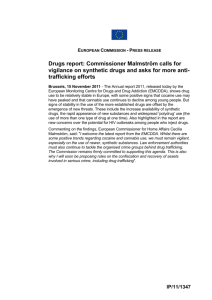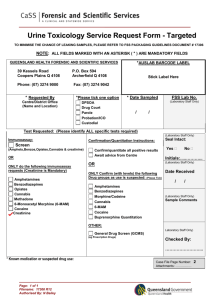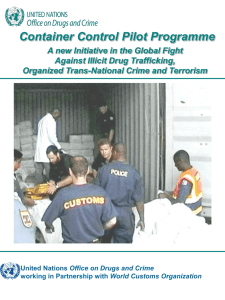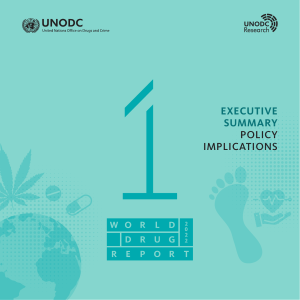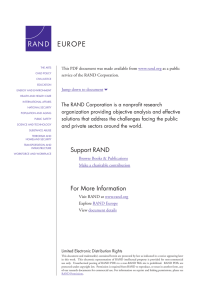pps - emcdda
advertisement
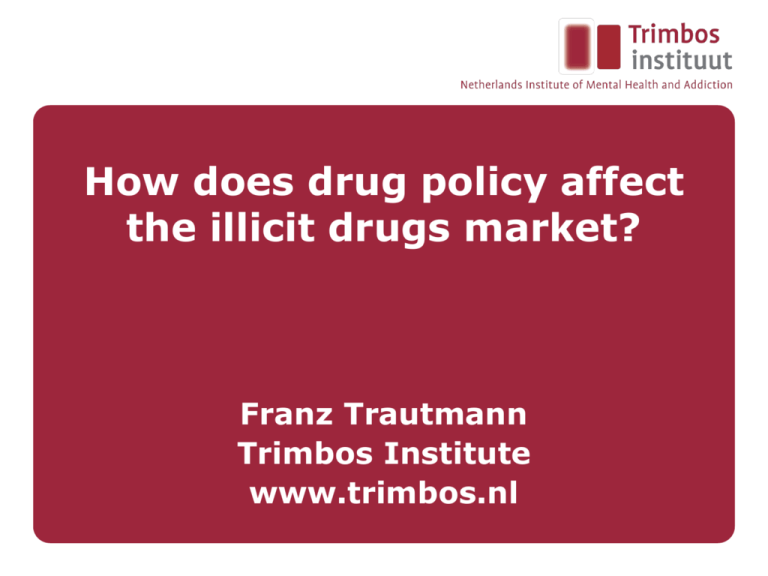
How does drug policy affect the illicit drugs market? Franz Trautmann Trimbos Institute www.trimbos.nl Based on Trimbos/RAND study on global illicit drugs markets 1998-2007 (ed. Reuter and Trautmann) Covering: • Analysis of the operation of the global market for illicit drugs – • • • • • • Cocaine, heroin, marijuana, Amphetamine Type Stimulants (ATS) Estimating seize of the market Estimating economic costs of drug use What has happened to the market 1998-2007 What were the policies of the period How did these policies affect the markets Analysing unintended consequences of drug policy Outline • Drug policy 1998-2007: – Demand reduction – Supply reduction • Drug problems 1998-2007: – Consumption – Supply • Unintended consequences • Policy analysis General policy trends • Drug policy expenditures in many countries increased substantially • The biggest share of expenditures for supply reduction • Measures against production and trafficking intensified substantially • Demand and harm reduction measures intensified and (the latter) spread to more nations Drug policy expenditures in four countries Demand reduction Supply reduction Hungary 2000 Total drug policy expenditures €22million €4 million1 €16 million Hungary 2007 €40million €7million1 €30 million Czech Republic 2002 Czech Republic 2006 United States 20044 United States 20064 The Netherlands €7 million2 €6 million €1 million3 €13 million2 €7 million €6 million3 $13 billion $5 billion $7 million $12 billion $5 million $8 billion €2,185 million €540 million5 €1,646 million Convergence of policies: demand side • Strong political support for prevention – Growing emphasis on proven effective programmes – Few demonstrated programs of even modest effectiveness – Many implemented programs ineffective • Increasing budgetary and political support for treatment • OST is spreading – Even to unlikely countries, e.g. China, Iran – In 26 of 27 EU Member States Convergence of policies: demand side • Other Harm Reduction measures also spreading – Syringe Exchange Programs now in many countries – Even in U.S. though not with federal support • Reduced willingness to punish drug users – More decriminalization of drug use, mostly marijuana – Administrative sanctions for possession of small quantities for personal use – Few arrestees are incarcerated Emphasis on pushing arrested addicts into treatment Convergence of policies: supply side • Increasing toughness towards sellers • More arrested • Longer statutory sentences – Longer actual sentences • US exceptional in numbers incarcerated – European intensity probably one tenth European arrest figures rising Drug-law offences / arrests • In most countries use and possession still account for majority of arrests – cannabis offences dominate • Very few cannabis arrests lead to prison sentences Arrests for use/possession and dealing/trafficking 1998 2005 2,128 2005 Use + possession for use 7.8% 2005 Dealing + trafficking 92.2% Czech Republic 1,530 Hungary 6,670 7,616 91.7% 8.3% Netherlands 12,616 20,548 30.9% 68.8% Portugal 11,395 11,825 52.9% 47.1% Sweden 11,490 18,844 86.1% 13.9% Switzerland 63,2201 Turkey 8,360 (2002) 130,643 56,3421 (2006) 13,229 83% (2006) 48.0% 15%2 (2006) 52.0% 122,459 (2004) 86.4% 13.6% United Kingdom Drug consumption Western drug use largely stable or declining • Marijuana prevalence rates among youth falling – Some exceptions • Heroin dependent population aging and declining • Cocaine rising in Europe, falling in US • ATS patterns complex but numbers still rather small (with some exceptions, e.g. CZ) US High School Senior Use 19752007 10 Daily marijuana 8 6 4 2 30-day cocaine 0 1975 1977 1979 1981 1983 1985 1987 1989 1991 1993 1995 1997 1999 2001 2003 2005 2007 Source: Monitoring the Future Experimentation with cannabis is common in Western countries Total US Cocaine consumption 1988-2000 (in metric tons) 700 650 600 Cocaine 550 500 450 400 350 300 250 200 1988 1989 1990 1991 1992 1993 1994 1995 1996 1997 1998 1999 2000 Consumption indicators for nonWestern countries are weak • Cannabis use generally much lower than in US – – e.g. 2005 survey Mexico City: 3.2% of 12-17 year olds report ever using marijuana U.S figure 10 times as high • Heroin use stable except for major epidemic in Russia and Central Asia • Cocaine use slight outside of Western countries and a few in South America – Mexico still modest use levels despite its trans-shipment role • ATS unclear • Prevalence figures are stabilising in some (advanced) transitional countries in the past decade. • Drug use prevalence increased in developing countries. Supply side changes modest: opiates and cocaine • The production of opiates and cocaine is concentrated in very few countries – Afghanistan is by far the main producer of opium, Colombia of coca • No changes which countries produce, just some shifts in distribution across countries Supply side changes unclear and rather negative: ATS • ATS production is spread over several countries; • The number of production countries increased in past decade; • New producers: in particular transitional countries; • ATS production diverse, from small-scale kitchen laboratories to large industrial-scale laboratories; • Some shifts in quantities produced from countries with intensified control to countries with less control. Supply side changes diffuse and rather negative: Cannabis • Cannabis production in more than 172 countries. • Cannabis resin production more concentrated than cannabis herb production; – cannabis resin in 58 – 116 for cannabis herb production. • Mexico and Morocco only large scale exporters but account for small share of total consumption • An increasing number of countries are involved in cannabis herb production. • Cannabis herb production takes diverse forms, from small-scale home growing to large-scale agricultural business Supply side changes: trafficking • Impact of anti-trafficking measures on quantities trafficked hard to measure – Seizures indicator for trafficking routes rather than for trafficked quantities • Changes in trafficking routes occur every few years – Central Asia heroin trafficking post-1995 – West African cocaine route post-2005 Unintended policy consequences on drugs market • Increasing interdiction rates for trafficking may lead to greater export demand; • Violence of producers, traffickers, dealers and users as response to tougher enforcement; • Large black markets generate incentives for corruption; • Environmental and health damage caused by enforcement induced replacement of big methamphetamine laboratories by smaller labs using varying ingredients Despite supply reduction efforts: prices have declined, e.g. in EU US cocaine and heroin prices have declined US enforcement up, prices down 450 $700 400 $600 350 $500 300 $400 250 200 $300 150 $200 100 $100 50 $0 0 02 00 98 96 94 92 Heroin Price (Scaled) 20 20 19 19 19 19 90 88 86 84 82 80 Drug Prisoners (Total) 19 19 19 19 19 19 Cocaine Price Number Incarcerated for Drug Law Violations (thousands) 500 Retail Price (2002 $/pure gram; divided by 6 for heroin) $800 Control efforts have minimal effect on global drug supply Examples: • Increased control efforts not reflected in prices of illicit drugs, especially in Western countries • Policy can reduce the nature and location of harms related to production and trafficking • Interventions can affect where production and trafficking occurs – Balloon effect: control efforts in Peru and Bolivia shift production to Colombia – 'Closing' of Netherlands Antilles smuggling route for cocaine to Europe may have supported West African route Drug policy has limited effects on drug demand • Drug use is driven by broader social, economic and cultural factors • Policy measures can not affect: – Whether an epidemic starts – Severity of epidemic – Prevalence of dependence • Policy can reduce harmfulness of drug use • Drug problems drive drug policy Selection of 18 countries for detailed study Criteria for selecting countries • Size (China and India) • Major role in production and/or trafficking (Iran and Colombia) • Major consumers (the United States) • Coverage of all regions of the globe • Substantial differences in the drugs problem they face (production, trafficking and use) • Differences in societal changes during the past ten years; – Western – Transitional – Developing Selected countries Australia Brazil Canada The Netherlands Portugal Russia China Colombia Czech Republic South Africa Sweden Switzerland Hungary India Mexico Turkey United Kingdom United States Principal methodological issues • No primary data collection – Analysed available data sources – EMCDDA, UNODC, national studies, expert opinion • Conceptual challenges: – Differences across nations in concepts and terminology (e.g. problem drug use) • Empirical challenges: – – – Data quality (e.g. political interests) Data scarcity Data inconsistency (e.g. differences in age groups and periods covered) • Data on non-Western countries extremely limited Production is very low cost


